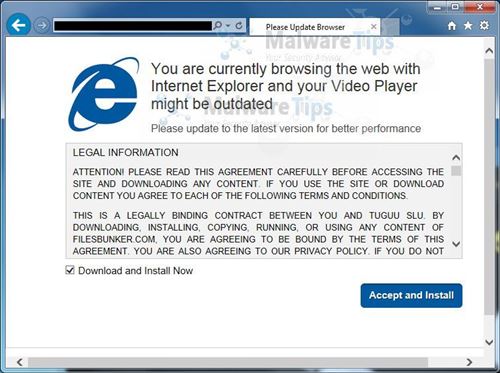A laptop recently landed on my desk full of some lovely viruses. I won’t say who it was, but really, you shouldn’t be too embarrassed. These virus writers are good at what they do and it’s easy to be tricked. As I fixed up the laptop, I thought about a short series of blog posts that might be of interest to many of you readers, not just the household that got hacked. I’ll cover how virus writers try to get you through your browser, how they attack via email, and then what to do after you suspect you’ve been hacked.
The most common viruses get onto your machine because you clicked something. It’s pretty difficult to have a computer sitting idle with no human in front of it and get a virus. We are the weakest link. So when hackers try to attack you via websites, they’re going to present you with something that is out of the ordinary, but just plausible enough that you’ll click on it. These popups might seem fairly legit. Here’s an example:

A geek will look at this and know it’s fake, but to the general populace, this seems like something serious that should be fixed by clicking Accept and Install. How can you tell it’s fake? That’s tricky but some basic ways are that this installation box is inside of a browser window. That’s your first red flag. What video player is it trying to update? If it’s going to install something, it should be pretty specific. If you have questions you could take that product name and search for it.
But really the best way to defend against this type of thing is to know the legitimate ways you’ll be warned about this type of thing and then be incredibly suspicious of anything that tells you to install something or “click here to fix your computer.” These days, nearly everything that is needed to fix your computer happens automatically in the background via Windows Update. You might see some notifications from Microsoft Security Essentials when you haven’t run a scan in a while but that’s about it.
You should also have Windows User Account Control enabled. Whenever a program tries to install on your machine or access protected areas of the operating system, it will pop up a warning dialog that asks if you’re sure you know what’s going on. Unfortunately if you believed something like the image above then this probably won’t stop you, but it’s a good backstop to really think about what you’re doing.
So if you get a popup that says you have a virus or that is asking you to install something unexpected, just stop. It’s probably a lie, but just in case it’s legitimate and Microsoft Security Essentials is trying to save you, snap a photo with your phone and email it to your favorite geek. Ask them if it’s legit and what you should click. You might save yourself a lot of trouble.
 I’ve been posting lots of quick, little examples showing off pieces of our Power BI offering, but now I’ve got a huge one for you. Our team recently acquired access to a HUGE data set of statistics. With the World Cup starting up, we decided to use World Cup statistics for a great demo.
I’ve been posting lots of quick, little examples showing off pieces of our Power BI offering, but now I’ve got a huge one for you. Our team recently acquired access to a HUGE data set of statistics. With the World Cup starting up, we decided to use World Cup statistics for a great demo.
 The general media has picked up on a huge bug that rocked the tech world this week. I’m sure it’s partially because it has such a great name and logo. But what is Heartbleed and how does it affect you?
The general media has picked up on a huge bug that rocked the tech world this week. I’m sure it’s partially because it has such a great name and logo. But what is Heartbleed and how does it affect you? I know I’ve been making a lot of Power Query posts lately, but once you get into it, you start seeing data everywhere! The latest example is a movie draft that I participate in with some friends. I won’t explain what a movie draft is except to say that it’s like fantasy football for movies. We participate in a huge league run by Brian Brushwood and friends. They post a spreadsheet with all the data here:
I know I’ve been making a lot of Power Query posts lately, but once you get into it, you start seeing data everywhere! The latest example is a movie draft that I participate in with some friends. I won’t explain what a movie draft is except to say that it’s like fantasy football for movies. We participate in a huge league run by Brian Brushwood and friends. They post a spreadsheet with all the data here:  If you’re running Windows 8, you probably got a pretty big update this week. The Windows team has been listening to the feedback and has made some pretty key tweaks to improve your user experience. PCWorld
If you’re running Windows 8, you probably got a pretty big update this week. The Windows team has been listening to the feedback and has made some pretty key tweaks to improve your user experience. PCWorld  A while back I
A while back I  In yesterday’s post about all my Amazon orders, JonathanC posted an interesting comment: “How about this one as a Power BI challenge: current value of the portfolio if you had purchased stock of Amazon instead of the product.” … Challenge accepted!
In yesterday’s post about all my Amazon orders, JonathanC posted an interesting comment: “How about this one as a Power BI challenge: current value of the portfolio if you had purchased stock of Amazon instead of the product.” … Challenge accepted! So now you’ve failed
So now you’ve failed 

 My project at work is called Power Query for Excel. We released our first version last summer and now our second version is available as part of a larger offering called “Power BI for Office 365.” BI stands for Business Intelligence. The offering includes a bunch of tools that help you make sense of your data, create nice reports and then share them out with your colleagues. This marks the first time that something I’ve worked on at Microsoft is available for purchase!
My project at work is called Power Query for Excel. We released our first version last summer and now our second version is available as part of a larger offering called “Power BI for Office 365.” BI stands for Business Intelligence. The offering includes a bunch of tools that help you make sense of your data, create nice reports and then share them out with your colleagues. This marks the first time that something I’ve worked on at Microsoft is available for purchase!